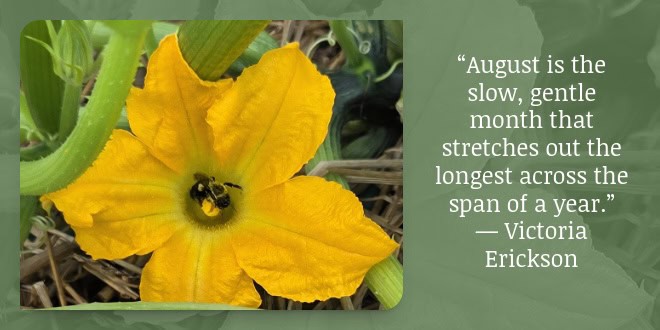
I’m having a hard time believing that July is over, but I’m kind of glad that it is, since we seem to have left those miserable temperatures and humidity behind with it. With the coming of August comes the real work of harvesting all of the lovely things we have been nurturing in our gardens, and I don’t know about you, but I am loving it!
Jennifer
This month’s issue of Let’s Get Gardening
Subscribe to our monthly newsletter for seasonal gardening advice and recommendations for your garden, yard, and bird feeding.
I hate to say it, but we can’t only harvest all those lovely vegetables this month. There’s a lot more to do to keep our gardens going:
- Overall for your gardens and lawn, keep an eye on the amount of rain you are getting in your yard – don’t just go by what the weather sites say we got, because they aren’t measuring the rainfall in your gardens. For example, my yard seems to have some sort of force field around it that often means that everyone else is getting plenty of rain, but my gardens are dry. So even though it seems like there’s been a lot of rain lately, I only got the benefit of it in the last week. Before that, I was dragging hoses around to keep things watered. A good rain gauge – on sale this month! – is the best way to know what your garden is getting, and the best way to know if you need to supplement Mother Nature’s offering (I couldn’t resist this “Mad Scientist” rain gauge shown below that I found from one of our vendors – he’s both functional and fun in my garden!). Everything needs at least an inch of water every week, and when the temps go really high, they need even more. If your rain gauge isn’t showing that much rain each week, it’s time to water.
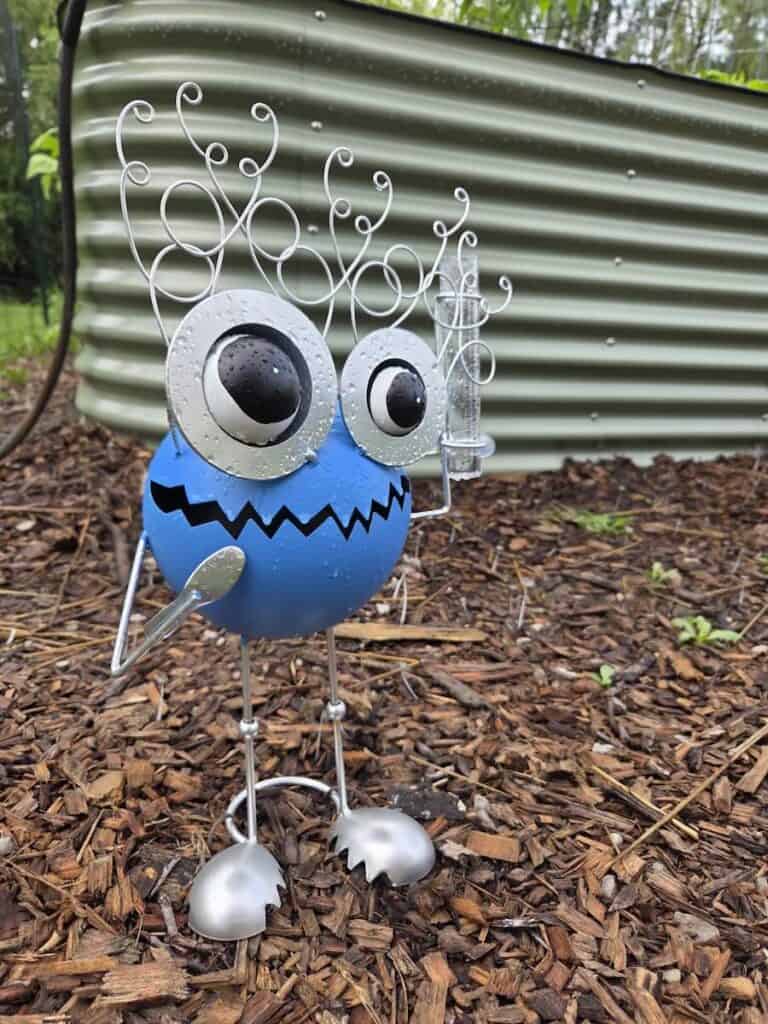
- New trees and shrubs should also be given more water than you might think. Trees and shrubs planted in the last two to three years – and especially those planted this year – aren’t as good at taking water up from the soil as established trees, so you really want to give them regular waterings to ensure that they don’t get stressed by drying out.
In the Vegetable Garden:
- Harvesting is the major activity of vegetable gardening in August. I love going out to my garden every morning to see what I might be able to have for dinner that night. Isn’t it amazing how zucchini can grow from just a tiny little fruit to a baseball bat seemingly overnight?! Be sure to stay on top of picking at this time. Many of your vegetable plants, including zucchini, cucumbers, and beans will stop producing if you don’t keep harvesting.
- August is also the time to put some “succession” plants in your veggie garden. Beets, radishes, lettuces, spinach, Swiss chard, kale, and peas all can be planted in August for harvest into the early fall. Take a look at the seed packet for the “days to maturity” to determine how late you can plant and still harvest before frost (and some things, like kale, are even better after a light frost). To figure out your safe planting timeframe, just count backwards from your average first date of frost (usually early October for our area, but you can get detailed information for your zip code here). So, if your packet says that the days to maturity is 45 and it takes 5 to 10 days to germinate, then you need to make sure that you have your seeds planted by about August 10th.
- The high humidity and heavy dews we’ve had the last few weeks have been perfect conditions for diseases to get going, such as powdery mildew and downy mildew in zucchini, cucumbers, and melons; leaf spots in tomatoes; blight in tomatoes, peppers, and potatoes; and bacterial spot and blight in beans. Treat your garden with fungicide on a regular basis in order to prevent diseases. It’s best to take a proactive approach in order to keep diseases from destroying your plants before you can get a good harvest. If you’re already seeing signs of problems, but you’re not sure what you’re dealing with, the Cornell College of Agriculture and Life Sciences offers some tips on how to identify diseases. Once you know what you’re dealing with, you can check labels on products to see if a particular product can help solve the problem, but be aware that most diseases can’t be cured, only prevented or possibly slowed. Your best bet is to treat your plants on a regular basis with a fungicide that works to control the diseases that affect your plants.
- Along with regular applications of fungicide, some other steps to take to minimize disease pressure on your plants include planting disease-resistant varieties, promptly removing and disposing of any plant parts that show signs of disease, pruning plants and spacing them well apart and to allow for good air flow, and keeping weeds and insects under control. It’s a little late in the season for planting disease-resistant varieties, but the rest are things you can definitely do. When doing any pruning, keep alcohol on hand, and clean your pruning tools before moving on to another plant so that you minimize the chances of spreading diseases from one plant to another. If you are working on plants that are already showing signs of disease, clean your tools after each cut. Working in your garden when everything is wet – either from rain or dew/humidity – is an almost guaranteed way to spread disease with your tools and gloves or clothing, as spores are easily picked up when you come in contact with one plant and then another.
- What’s bugging your garden these days? In my gardens, the Japanese beetles were one of the biggest issues last month, and I heard from many customers that they also had issues with them. My advice for dealing with them has been the same for years – DO NOT put those trap bags in your yard. The only thing those do is attract more of the beetles to your yard. Do go out every day with a bucket of soapy water and knock the beetles off your plants and into the water. The soap coats their wing so they can’t fly out, and the water will eventually drown them. Spraying them with insecticides can be somewhat helpful, but anything you use on them is also harmful to the beneficial insects in your garden, so be careful when and where you spray. Don’t directly spray open flowers that bees might be visiting, and spray in the evening, when bees are likely to be less active.
- Japanese beetles aren’t the only bugs I’ve been fighting in my garden lately. I’ve also been trying to keep tomato hornworms, squash bugs, squash vine borers, and Colorado potato beetles under control – with varying levels of success. Controlling them is important, not just because they eat your hard work, but because they also transmit infection from diseased plants they’ve visited to your otherwise healthy plants.
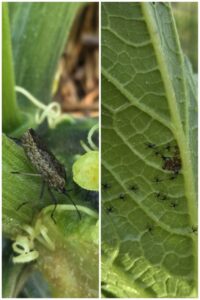
- My strategy for squash bugs is mostly scouting for and removing eggs on a regular basis. Squash bug eggs are generally a dark brown or copper color, and can be found in clusters on the undersides of leaves. Scraping them off the leaves and dropping them in a bucket of water is the most effective way of dealing with them. If, however, you don’t find and dispose of the eggs before they hatch, you’ll find the nymphs, which look somewhat like tiny black spiders, close by. For those, a quick squirt of Neem Oil generally does the trick. If you miss the nymph stage, you will likely find adult bugs hanging around your plants. Those can rather easily be plucked off and squashed underfoot (isn’t that why they’re called squash bugs?).
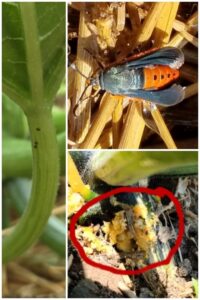 Dealing with squash vine borers can be a real pain, if you don’t get them at the egg stage. Look for the eggs of the vine borer on the stems of your plants. You’ll usually find only one to three of the dark brown oval-shaped eggs on a stem, but you might find them on multiple stems. As with squash bug eggs, scraping them off and dunking them in a bucket of water takes care of them. If you miss the eggs, and they hatch, the next sign you will see of these destructive creatures is likely a hole in the stem that looks like it has sawdust coming out of it. That’s a sign that the larva has bored in and is eating its way to destroying your plant. There are a few ways to deal with this stage, but whatever you do, do it quickly. If they really get going, it’s the end of your plant.My preferred method for dealing with them is to inject Bt (bacillus thuringiensis) into the stems of the plants using a syringe. I do this every 5 to 7 days wherever I see signs of the borers, and also into stems that are not showing any signs of infestation, as a preventative. Bt is a naturally-occurring bacteria that is only harmful to the larva (caterpillars) of insects in the lepidopteran family (butterflies and moths),including hornworms, cabbage loopers, and armyworms. If you’re a little nerdy like me, and you want all the details of the discovery of Bt and how it kills these larva, check out this article from Planet Natural. Timing of this method is critical, as you need to get to the borers before they do too much damage. Simply spraying the plants with Bt is ineffective with these creatures, because they are feeding inside the stems, and generally won’t come in contact with the poison. You can also try gently slitting the stem open with a very sharp knife until you find the borer and removing it. Then bury the stem with soil to allow it to put out new roots. I have never really been successful in saving my squash plants with this method, but I have heard others say they have, so it could be worth trying.
Dealing with squash vine borers can be a real pain, if you don’t get them at the egg stage. Look for the eggs of the vine borer on the stems of your plants. You’ll usually find only one to three of the dark brown oval-shaped eggs on a stem, but you might find them on multiple stems. As with squash bug eggs, scraping them off and dunking them in a bucket of water takes care of them. If you miss the eggs, and they hatch, the next sign you will see of these destructive creatures is likely a hole in the stem that looks like it has sawdust coming out of it. That’s a sign that the larva has bored in and is eating its way to destroying your plant. There are a few ways to deal with this stage, but whatever you do, do it quickly. If they really get going, it’s the end of your plant.My preferred method for dealing with them is to inject Bt (bacillus thuringiensis) into the stems of the plants using a syringe. I do this every 5 to 7 days wherever I see signs of the borers, and also into stems that are not showing any signs of infestation, as a preventative. Bt is a naturally-occurring bacteria that is only harmful to the larva (caterpillars) of insects in the lepidopteran family (butterflies and moths),including hornworms, cabbage loopers, and armyworms. If you’re a little nerdy like me, and you want all the details of the discovery of Bt and how it kills these larva, check out this article from Planet Natural. Timing of this method is critical, as you need to get to the borers before they do too much damage. Simply spraying the plants with Bt is ineffective with these creatures, because they are feeding inside the stems, and generally won’t come in contact with the poison. You can also try gently slitting the stem open with a very sharp knife until you find the borer and removing it. Then bury the stem with soil to allow it to put out new roots. I have never really been successful in saving my squash plants with this method, but I have heard others say they have, so it could be worth trying.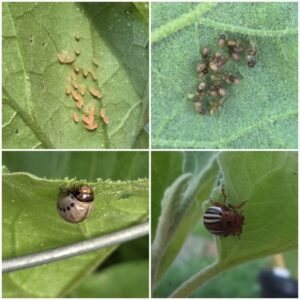
- Colorado potato beetles are one of the most destructive creatures in our gardens and have pretty much become immune to almost all insecticides, so keeping them under control is challenging. Get them at egg stage or early larva stage if you want to save your plants, as they are voracious eaters and can decimate potatoes, eggplants, peppers, and tomatoes in short order. I found eggs on one of my eggplants and very small larva on another about two weeks ago. I thought I had gotten them all and then found larger larva on the plants just the other day. So, I’ve been scouting those plants daily to try to keep them from eating my eggplants before I can get any fruit. Eggs are a yellow or orange football shape that can be found on the undersides of leaves. The very young larva look sort of like tiny snails with gray bodies and black heads. As the larva get older, they go through a few stages and colors but will retain the black head and have a row of black spots along both sides of their bodies. The adults have black heads and yellow bodies with black stripes running from head to tail. When I find eggs, I usually remove the entire leaf and drop it into the bucket of soapy water I keep handy. Same goes for the tiny larva. If I find larger larva or adults, I will generally pluck them off the leaves and squash them or drop them in the bucket. Here’s a surprising piece of information – stink bugs can be beneficial in keeping Colorado potato beetles under control by eating the eggs. Lady bugs will also eat the eggs. I’m not sure it’s worth having both of those in my house all winter, and stink bugs are pretty destructive in their own right, but if they’re around, at least they can do some good.
- OK –last word on the pests in my garden, I promise. I can’t not talk about tomato hornworms, though. Those stinkers have been showing up all over my tomato plants lately, chomping on the leaves, stems, and fruit, and I’ve had enough of them! Generally, you can tell that you have a problem if you notice that the leaves of your plants have been stripped clean off the stems or you see large sections missing from your green tomatoes (they don’t seem to like ripe fruit). The other tell-tale sign is finding their frass (aka excrement, poop) on your plants. Their droppings kind of look like small, black or green Rubik’s Cubes. If you find some, look in the leaves and stems above the droppings, and you should find the culprit. I had a heck of a time finding one of them recently, because it was still pretty small and they blend so well with the plants. It took me a couple of days to finally spot it, but when I did, I did what I usually do with them – I plucked it off the plant and put it in one of my bird feeders as a nice treat for a lucky bird! Bt also works on these, and spraying the leaves of the plants is effective. Just keep in mind that Bt can also kill caterpillars of insects you want to encourage in your garden, like butterflies and moths that pollinate your plants, so be careful in targeting your spraying.
In the Flower Garden:
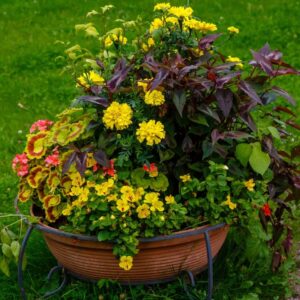
- Deadhead your annual flowers in beds and containers to ensure continuous blooms. Perennials that bloom at this time of year may also benefit from deadheading, either to encourage re-blooming, to keep seed spreading under control, or just to keep them looking good throughout the season.
- Be sure to monitor rainfall for your flower beds. Some flowers can be drought tolerant, but that doesn’t mean they can go without water for too long without suffering. Also be aware that, if you have flower beds planted up against your house, they may not always get the full effect of rain, depending on the direction the rain is coming from. If you notice plants looking dried out or wilting, even though you think you’re getting lots of rain, it may be time to give them supplemental water.
- Keep on top of weeds. Weeds compete with your plants for water and nutrients, and they can be a source of disease, so it’s best to get them before they get out of control. I know that’s a lot easier said than done, especially in the weather we’ve been having, but doing a little at a time can make it a little easier. I often stop to pull a few whenever I’m out doing something else, like getting the mail or filling my bird baths.
- Just as with vegetable gardens, diseases are a problem for flower gardens, and the same rules apply to flowers as vegetables – prevention is key: plant disease-resistant varieties when possible; allow ample space for airflow around plants; water at soil level, rather than overhead; clean up and remove infected plant material; for plants that are very susceptible to diseases such as powdery mildew and leaf spot, early and often fungicide application can help ward off problems before they begin.
For the Birds
- Keep your birdbaths cleaned out and filled, even if we are getting a lot of rain. Rain doesn’t disinfect birdbaths, and dirty bath water can lead to disease. When we’re not getting much rain, your birdbath may be the only nearby source of water for them when it’s dry.
- Also clean out and fill up hummingbird feeders regularly – at least twice a week in hot weather – so as not to promote bacteria, and to provide food and water for the hummers. Keep other bird feeders cleaned out as well – there are still avian diseases out there that can be transmitted via dirty feeders.
Read More
More info on all of these tips can be found in our monthly newsletter: Read the full August 2025 issue of Let’s Get Gardening
Happy Gardening!
August Sale – 20% Off
Rain Gauges, Watering Equipment & Bird Baths
In-Store and Online!
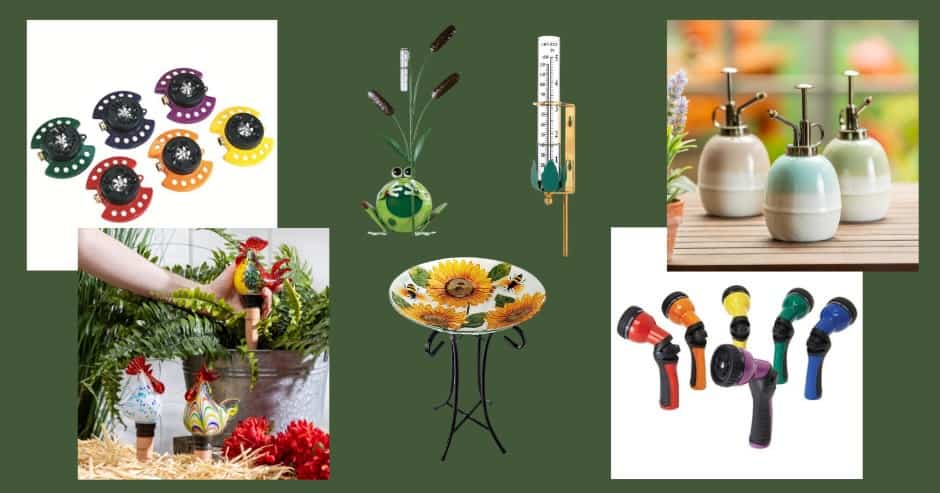
$10 off any $50 purchase

Expires 8/31/25
Cannot be combined with any other offer.
Not valid on artist consignment items.
Cannot be used to purchase gift certificates.
